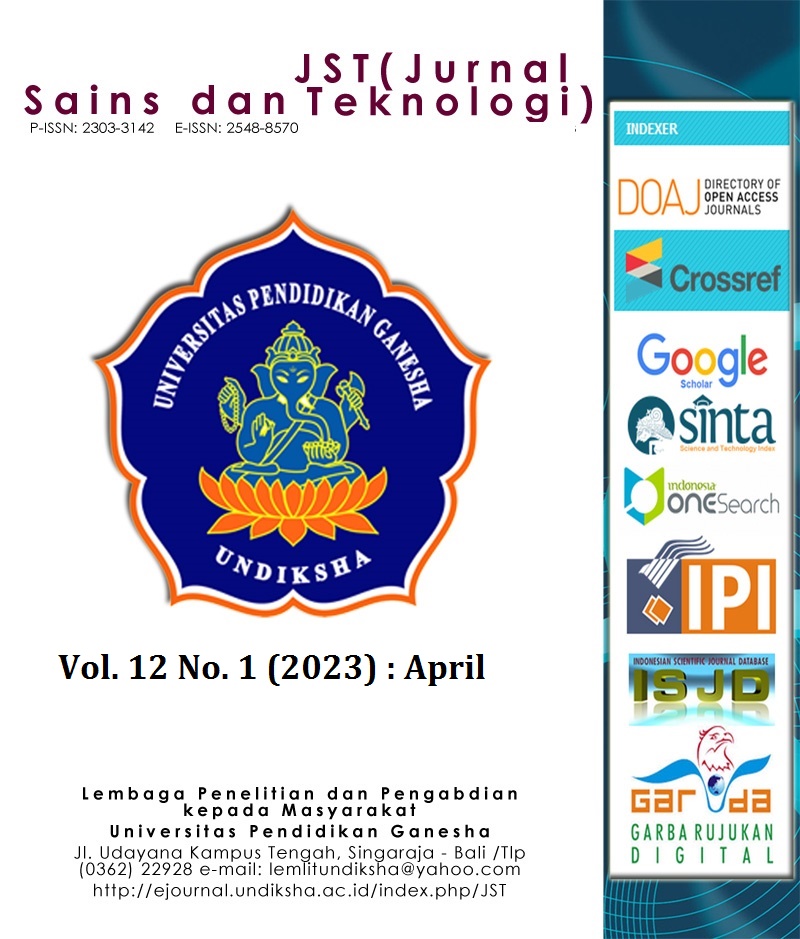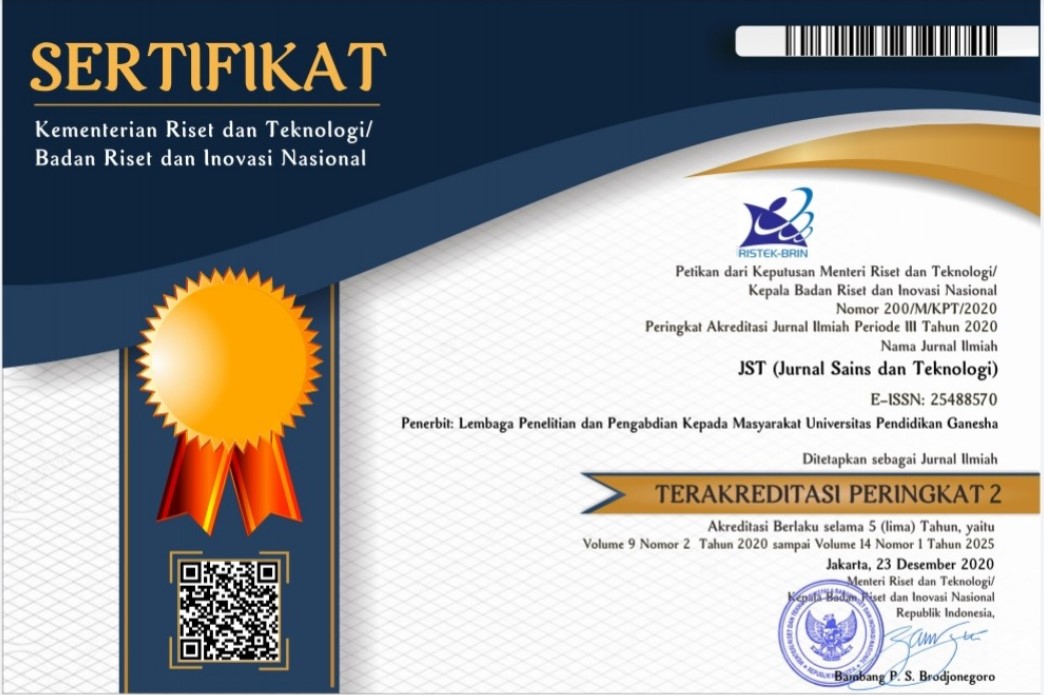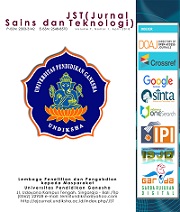Prototype of a Baby Incubator Physical Parameter Measurement Tool: Temperature, Humidity, Airflow and Noise Level
DOI:
https://doi.org/10.23887/jstundiksha.v12i1.40855Kata Kunci:
Incubator analyzer, temperatur, kelembaban, kecepatan aliran udara, tingkat kebisinganAbstrak
The Incubator Analyzer is equipment to measure the physical parameters contained in the baby incubator to verify the output value of the device and ensure the safety of the equipment for patient care. Currently, there are several products of baby incubator analyzer in Indonesia, but the availability of goods is still imported with relatively expensive product prices, so in this article, we report the development of a prototype baby incubator physical parameter measurement equipment to support the domestic product independence program. The method that has been carried out in this research is experimental in designing and developing a baby incubator physical parameter by maximizing the availability of components in the local market. Design of the prototype refers to SNI IEC 60601-2-19-2014 which is a standard of special requirements for basic safety and essential performance of infant incubators, with the measured parameters consisting of measurements of air temperature in the incubator room, mattress temperature, humidity, airflow, and noise level. The temperature measurement design uses a resistive temperature detector PT 100, SHT 11 as a humidity sensor, GFS131 as an airflow sensor, MAX4466 as a microphone amplifier as a sound sensor, and a 3.5” nextion TFT LCD as a display. This prototype is also equipped with a rechargeable battery system as a portable power supply. The testing is carried out by comparing the results read by a device designed with the Incu Analyzer II Fluke Biomedical. The results show that the prototype of the baby incubator parameter measuring instrument is able to read the values of temperature, humidity, airflow, and noise level in the baby incubator chamber. The accuracy of temperature parameter measurement reaches more than 98%, so this prototype has the potential to be tested by authorized institutions.
Referensi
Altayyar Saleh, S., Mousa, M. A., Alfaifi, A. M., Negm, A. E., & Ali, M. O. (2018). The impact of calibration on medical devices performance and patient safety. Biomedical Research (India), 29(12), 2553–2560. https://doi.org/10.4066/biomedicalresearch.29-18-550.
Athavale, V. A., Pati, A., Hossain, A. K. M. B., & Luthfiyah, S. (2022). An Android INCU Analyzer Design to Calibrate Infant Incubator Using Bluetooth Communication for Real-Time and Wireless Monitoring. 15(1), 1–8. https://doi.org/10.35882/teknokes.v15i1.1.
Azkiyak, V. N., Syaifudin, S., & Titisari, D. (2020). Incubator Analyzer Using Bluetooth Android Display (Humidity & Air Flow). Indonesian Journal of Electronics, Electromedical Engineering, and Medical Informatics, 1(2), 71–77. https://doi.org/10.35882/ijeeemi.v1i2.5.
Badan Standarisasi Nasional. (2014). SNI IEC 60601-2-19:2014 : Persyaratan khusus untuk keselamata dasar dan kinerja esesensial inkubator infant.
Bess, F. H., & Bess, H. (2015). Observations on Noise Levels in Infant Incubators. July. https://doi.org/10.1542/peds.63.1.100.
Chowdhury, M. R. (2012). General Concept of Calibration. International Journal of Pharmaceutical and Life Sciences, 1(3), 2305. https://doi.org/10.3329/ijpls.v1i3.12981.
Ferris, T. K., & Shepley, M. M. (2013). The design of neonatal incubators: A systems-oriented, human-centered approach. Journal of Perinatology, 33(SUPPL. 1), 24–31. https://doi.org/10.1038/jp.2013.11.
Golpaygani, T. (2019). Journal of Biomedical Physics and Engineering. 251–256. https://doi.org/10.31661/jbpe.v0i0.761.
Latif, A., Widodo, H. A., Atmoko, R. A., Phong, T. N., & Helmy, E. T. (2021). Temperature and humidity controlling system for baby incubator. Journal of Robotics and Control (JRC), 2(3), 190–193. https://doi.org/10.18196/jrc.2376.
Ningtias, D. R., Wahyudi, B., & Harsoyo, I. T. (2021). Monitoring Suhu pada Infant Warmer Menggunakan INCU Analyzer Berbasis Arduino. Elektrika, 13(1), 22. https://doi.org/10.26623/elektrika.v13i1.3118.
OMBUDSMAN. (2018). Kalibrasi Alat Kesehatan Dalam Rangka Peningkatan Pelayanan Kesehatan Publik di Puskesmas (p. 12).
Ozdemİrcİ, E., Özarslan Yatak, M., Duran, F., & Canal, M. R. (2014). Reliability assessments of infant incubator and the analyzer. Gazi University Journal of Science, ISBN: 27(4), 1169–1175.
Restin, T., Gaspar, M., Bassler, D., Kurtcuoglu, V., Scholkmann, F., & Haslbeck, F. B. (2021). Newborn incubators do not protect from high noise levels in the neonatal intensive care unit and are relevant noise sources by themselves. Children, 8(8). https://doi.org/10.3390/children8080704.
Saleh, A. R. (2013). Mengenal ICS Sebagai Salah Satu Sistem Klasifikasi Dokumen. Media Pustakawan, 20(1), 5–8. https://ejournal.perpusnas.go.id/mp/article/view/895.
Samputri, H. N. A., Syaifudin, S., & Titisari, D. (2019). Incubator Analyzer Menggunakan Aplikasi Android. Jurnal Teknokes, 12(1), 14–20. https://doi.org/10.35882/teknokes.v12i1.3.
Sen, G. T., & Yuksekkaya, M. (2018). Desing and Test of an Incubator Analyzer. ISMSIT 2018 - 2nd International Symposium on Multidisciplinary Studies and Innovative Technologies, Proceedings, 2–6. https://doi.org/10.1109/ISMSIT.2018.8567049.
Sensirion. (2004). Humidity & Temperature Sensor. 1–9.
Syarifatul Ainiyah, Andayani, D. H., Pundji, A., & Shaib, M. (2020). Development of Incubator Analyzer Based on Computer with Temperature And Humidity Parameters. Journal of Electronics, Electromedical Engineering, and Medical Informatics, 2(2), 48–57. https://doi.org/10.35882/jeeemi.v2i2.3.
Vasilevskyi, O. M. (2014). Calibration method to assess the accuracy of measurement devices using the theory of uncertainty. International Journal of Metrology and Quality Engineering, 5(4). https://doi.org/10.1051/ijmqe/2014017.
Wijaya, R. A., Lestari, S. W. L. W., & Mardiono, M. (2019). Rancang Bangun Alat Monitoring Suhu dan Kelembaban Pada Alat Baby Incubator Berbasis Internet Of Things. Jurnal Teknologi, 6(1), 52. https://doi.org/10.31479/jtek.v6i1.5.
Wongkamhang, A., Phasukkit, P., Pintuviroj, C., Prasantamrongsiri, S., Sanpanich, A., & Thongpance, N. (2013). Design and Simulation of Air Flow Inside Double Study for Multi Inflow and Outflow Slot . 3–6. https://doi.org/10.1109/BMEiCon.2013.6687694.
Zacarías, F. F., Jiménez, J. L. B., Velázquez-gaztelu, P. J. B., Molina, R. H., & López, S. L. (2018). Noise level in neonatal incubators: A comparative study of three models. International Journal of Pediatric Otorhinolaryngology. https://doi.org/10.1016/j.ijporl.2018.02.013.
Unduhan
Diterbitkan
Cara Mengutip
Terbitan
Bagian
Lisensi
Hak Cipta (c) 2022 JST (Jurnal Sains dan Teknologi)

Artikel ini berlisensiCreative Commons Attribution-ShareAlike 4.0 International License.
Authors who publish with the Jurnal Sains dan Teknologi (JST) agree to the following terms:
- Authors retain copyright and grant the journal the right of first publication with the work simultaneously licensed under a Creative Commons Attribution License (CC BY-SA 4.0) that allows others to share the work with an acknowledgment of the work's authorship and initial publication in this journal.
- Authors are able to enter into separate, additional contractual arrangements for the non-exclusive distribution of the journal's published version of the work (e.g., post it to an institutional repository or publish it in a book), with an acknowledgment of its initial publication in this journal.
- Authors are permitted and encouraged to post their work online (e.g., in institutional repositories or on their website) prior to and during the submission process, as it can lead to productive exchanges, as well as earlier and greater citation of published work. (See The Effect of Open Access)
















